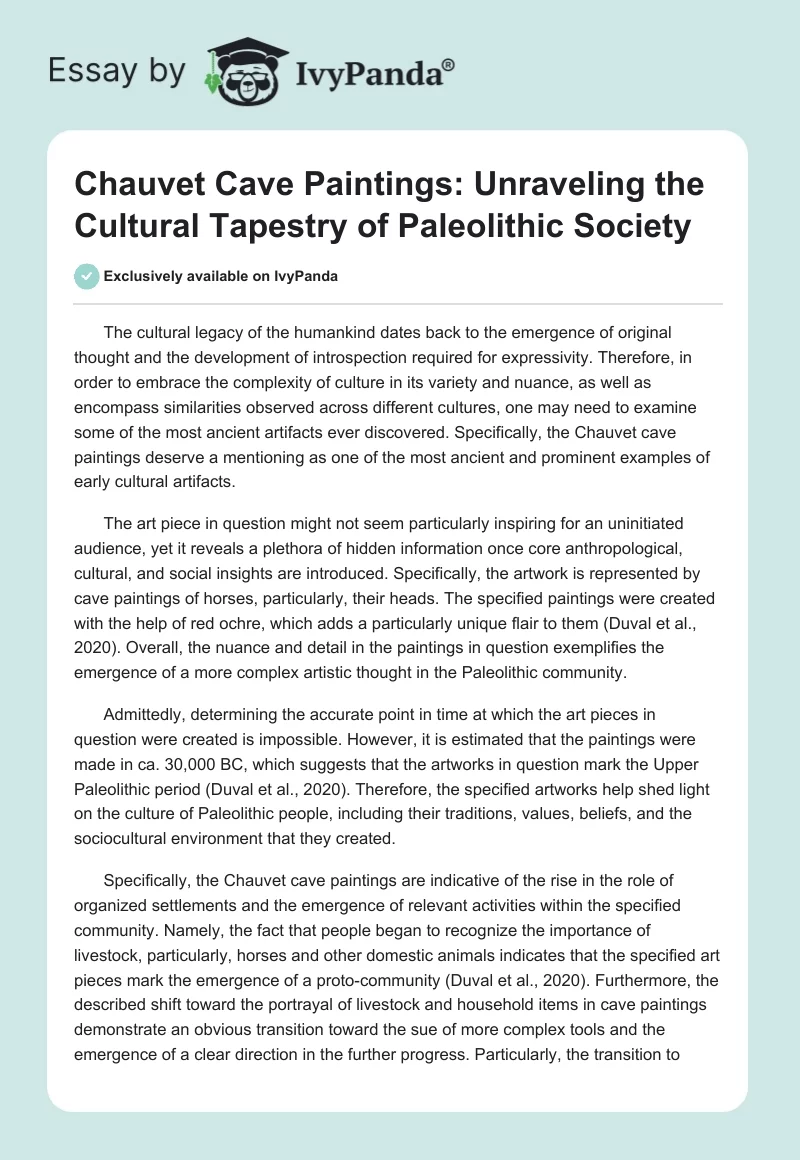The cultural legacy of the humankind dates back to the emergence of original thought and the development of introspection required for expressivity. Therefore, in order to embrace the complexity of culture in its variety and nuance, as well as encompass similarities observed across different cultures, one may need to examine some of the most ancient artifacts ever discovered. Specifically, the Chauvet cave paintings deserve a mentioning as one of the most ancient and prominent examples of early cultural artifacts.
The art piece in question might not seem particularly inspiring for an uninitiated audience, yet it reveals a plethora of hidden information once core anthropological, cultural, and social insights are introduced. Specifically, the artwork is represented by cave paintings of horses, particularly, their heads. The specified paintings were created with the help of red ochre, which adds a particularly unique flair to them (Duval et al., 2020). Overall, the nuance and detail in the paintings in question exemplifies the emergence of a more complex artistic thought in the Paleolithic community.
Admittedly, determining the accurate point in time at which the art pieces in question were created is impossible. However, it is estimated that the paintings were made in ca. 30,000 BC, which suggests that the artworks in question mark the Upper Paleolithic period (Duval et al., 2020). Therefore, the specified artworks help shed light on the culture of Paleolithic people, including their traditions, values, beliefs, and the sociocultural environment that they created.
Specifically, the Chauvet cave paintings are indicative of the rise in the role of organized settlements and the emergence of relevant activities within the specified community. Namely, the fact that people began to recognize the importance of livestock, particularly, horses and other domestic animals indicates that the specified art pieces mark the emergence of a proto-community (Duval et al., 2020). Furthermore, the described shift toward the portrayal of livestock and household items in cave paintings demonstrate an obvious transition toward the sue of more complex tools and the emergence of a clear direction in the further progress. Particularly, the transition to technological innovation and its application to solve main concerns, namely, searching for resources and maintaining safety, is evident in the paintings in question.
Finally, the Chauvet cave paintings may point to some of the societal issues emerging within the proto-community at the time. Namely, the transition toward the development of essential cultural milestones such as language, sociocultural values, spirituality, and even scientific inquiry was expressed in the artworks in question. Indeed, the shift from basic forms, shapes, and lines to the sue of much more sophisticated linework and detail points to the development of a more intricate understanding of art among Paleolithic people. Furthermore, one could argue that the pictures in question represented the early understanding of economic concerns since they indicated a more thorough understanding of the value of the livestock and the significance of agricultural activities.
Being one of the earliest and surprisingly nuanced artworks created by humans, the Chauvet cave paintings represent an incredible opportunity at examining the culture of the past and trace it back to the present days. In addition to remarkably close attention to details and the propensity toward abstract representation of the animals, the picture is also tethered to core sociocultural and socioeconomic developments within society at the time. Specifically, the focus on the role of the livestock can be seen clearly in the portrayal of horses as some of the most valuable animals in the household at the time.
Reference
Duval, M., Smith, B., Gauchon, C., Mayer, L., & Malgat, C. (2020). “I have visited the Chauvet Cave”: The heritage experience of a rock art replica. International Journal of Heritage Studies, 26(2), 142-162. Web.


